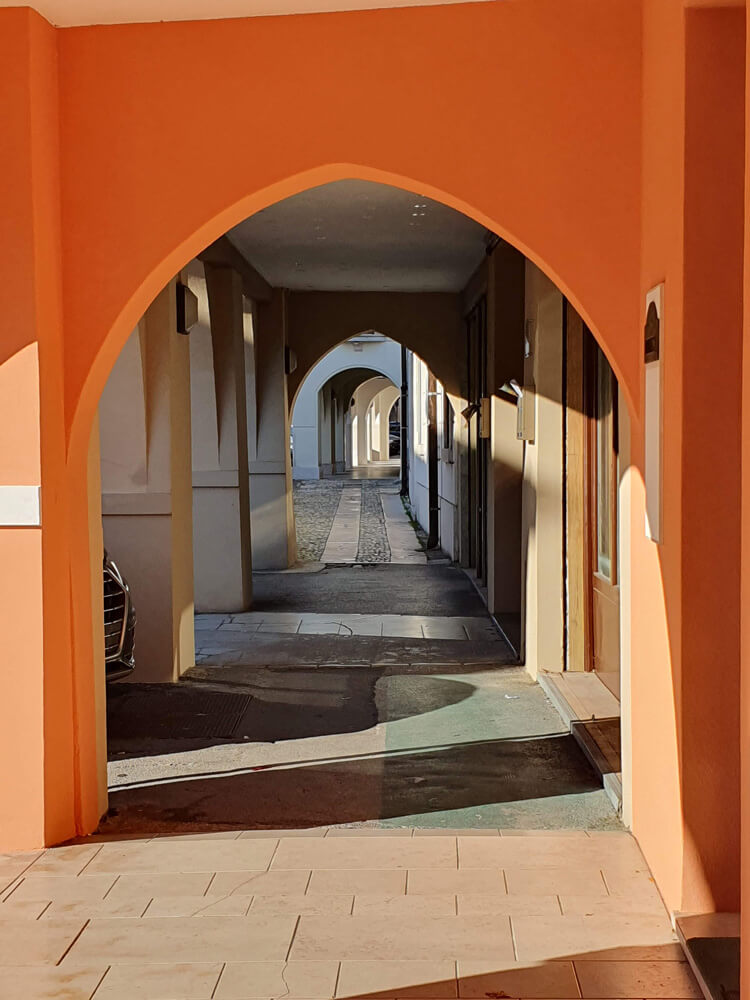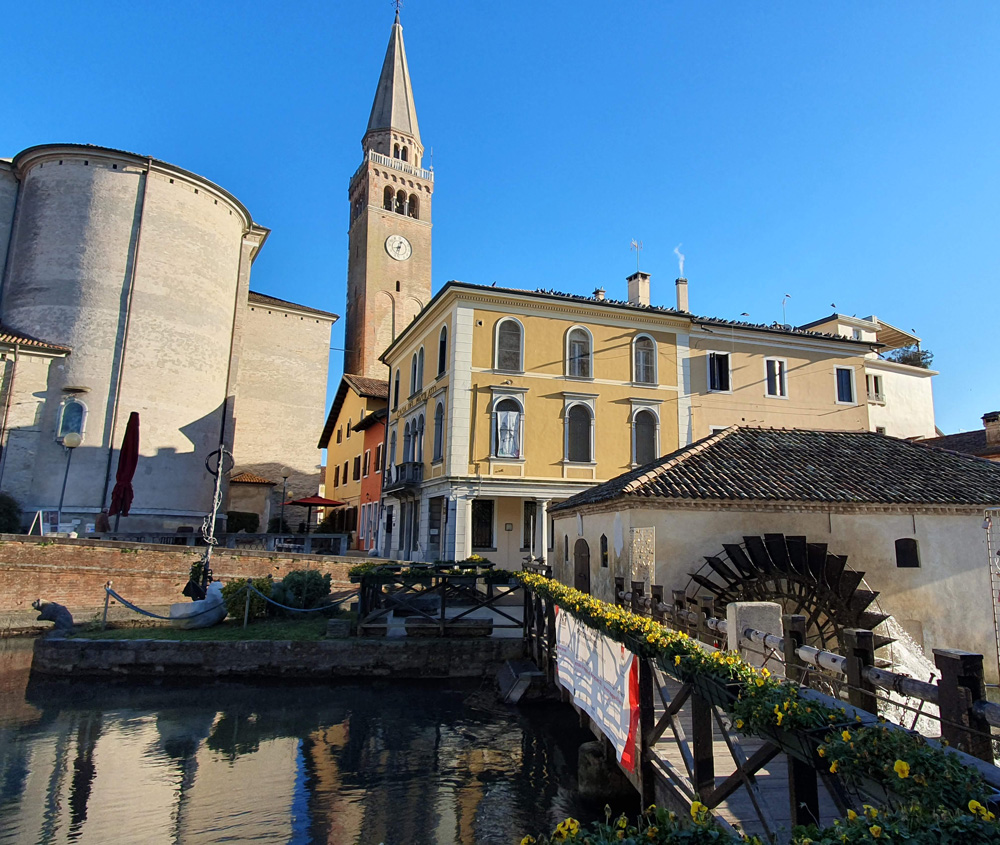Portogruaro is a hidden gem; an under-the-radar north-eastern Italian destination full of unexpected historic charm. Take in the riverside scene of splashing waterwheels and handsome arched buildings, and you’ll wonder why you haven’t visited before (at least, I did).
On the plain of the Veneto region, north of the Venetian lagoon and inland from coastal resort Caorle, Portogruaro (population: 25,000) is a transport hub, but not really on the tourist trail. Nearby magnets such as Venice and Treviso attract the area’s tourists, while handsome old towns like Portogruaro are largely left for their residents to enjoy.
Portogruaro was founded in the twelfth century on the banks of the River Lemene, close to an existing castle. As a river port in a strategic location, only a few miles upstream from the Adriatic sea, medieval Portogruaro grew prosperous. It stood between the fertile mainland, crossed with highways, and the marshy lagoon environment that gave way to the sea and connected up with the Venetian lagoon. For several centuries, some of them under Venetian rule, merchants and wealthy citizens built elegant public and private buildings here, many adorned with colourful frescoes. The town’s riches and importance dwindled from the seventeenth century onwards, along with the rest of the Venetian territories.
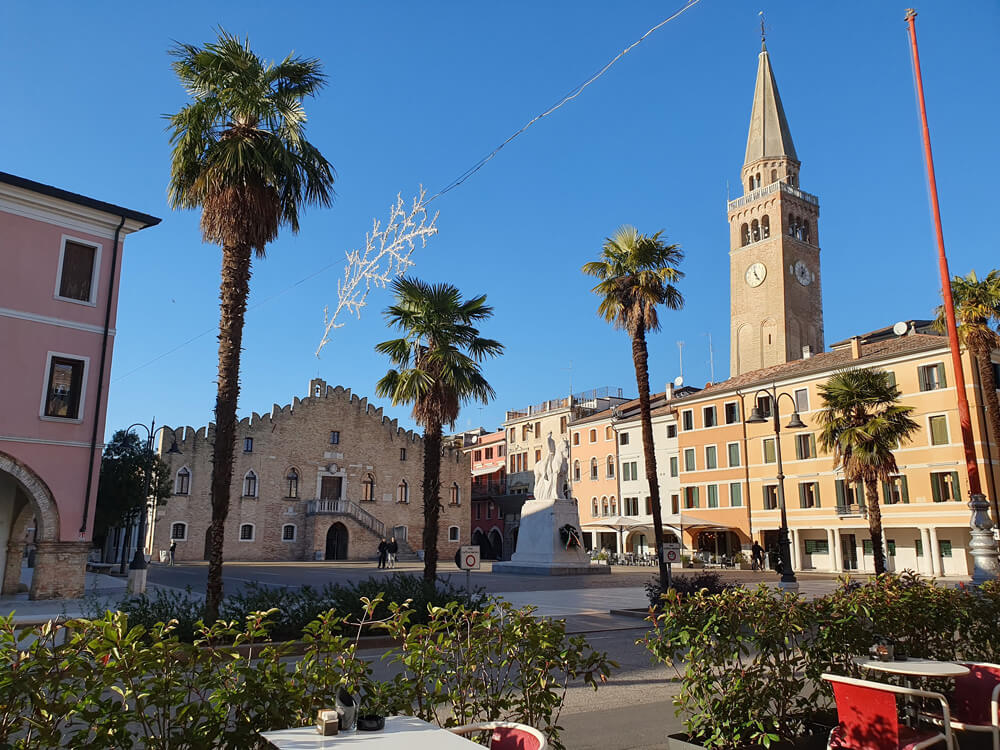
The river port is no longer busy with boats and fishermen, but the Lemene’s waters give Portogruaro a strong character even now, with its most picturesque view being a scene of water mills and arches across the river. Although it is within the Veneto region today, this area has strong historic and cultural ties to Friuli; the present-day border with Friuli-Venezia Giulia is close by, and you’ll find Friulian food specialities in the local restaurants.
The historic centre of Portogruaro is extremely handsome and unspoiled. Arcaded buildings typical of this part of Italy line its two principal streets, providing the public with sheltered walkways below. Some of the palazzi along the streets are impressively grand, and several still have faded and damaged frescoes clinging to their façades. An excellent archaeological museum is one of Portogruaro’s principal attractions, and houses Roman finds from nearby Concordia Sagittaria.
Although tourism provides some income for the area, it is mostly focussed in the seaside resorts of Caorle and Bibione. Portogruaro, still in a strategic position for local transport connections, makes a stopover or excursion destination for beachgoers or those travelling along the coast between Venice and Trieste. Read on for what to see, things to do, where to stay and travel/itinerary advice.
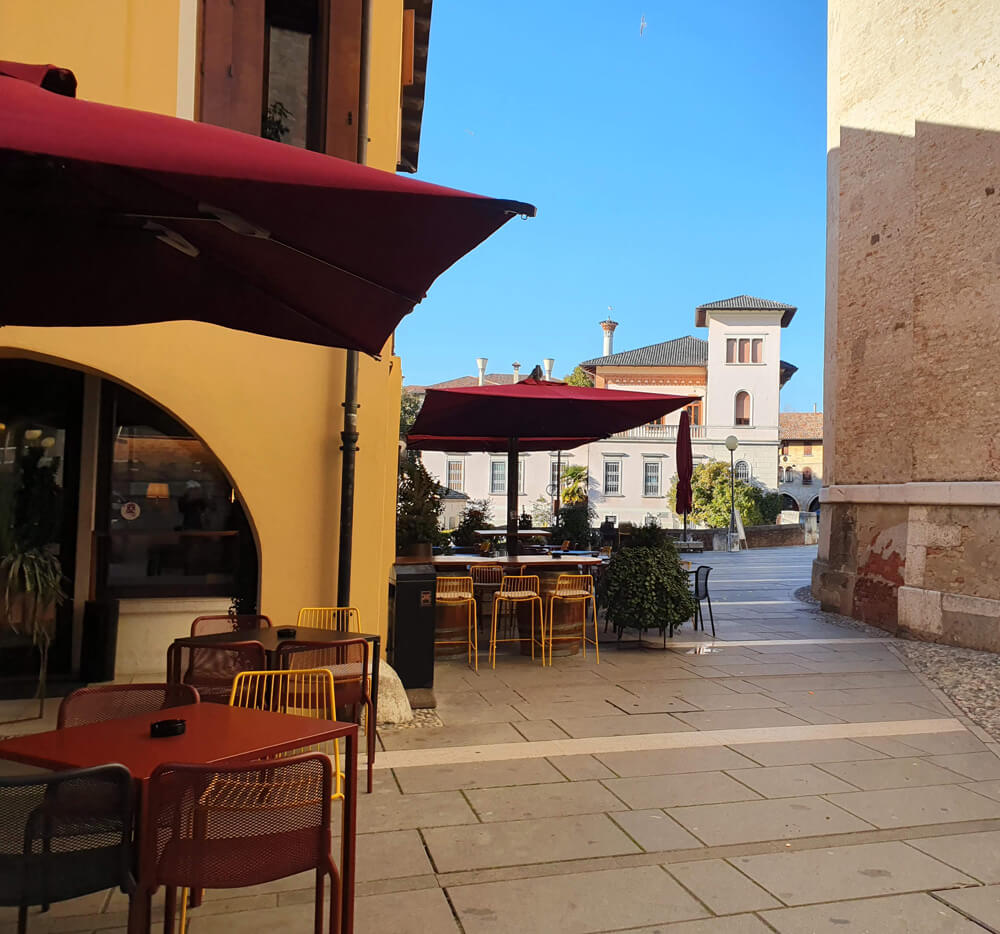
Exploring the town – what to see in Portugruaro
Portogruaro is blessed with two hugely picturesque spots at the heart of the town. The town’s focal point is Piazza della Repubblica, an attractive square dominated by the handsome town hall (Loggia or Palazzo Comunale, or Municipio) a Gothic brick palace topped with swallow-tail ghibelline merlons. The central part of the building dates to the fourteenth century; the later external staircase offers a good viewpoint for photo opportunities. The stone heads on the ground in front of the building are from the sixteenth century and originally stood on a bridge over the Lemene.
In the centre of the square is a war memorial. Café tables alongside the square add liveliness to the scene, and tall palm trees along the street add a summery Mediterranean feel to this north Italian setting. Don’t miss the Renaissance well-head to the left as you face the Palazzo Comunale; the two bronze birds (cranes), mounted on this are a symbol of the town. You can see more cranes on the base of the grand flagpole opposite the Palazzo Comunale, which is topped by a winged lion of St Mark. Another winged lion, emblem of the Venetian Republic, stands on a column a short distance down the street.
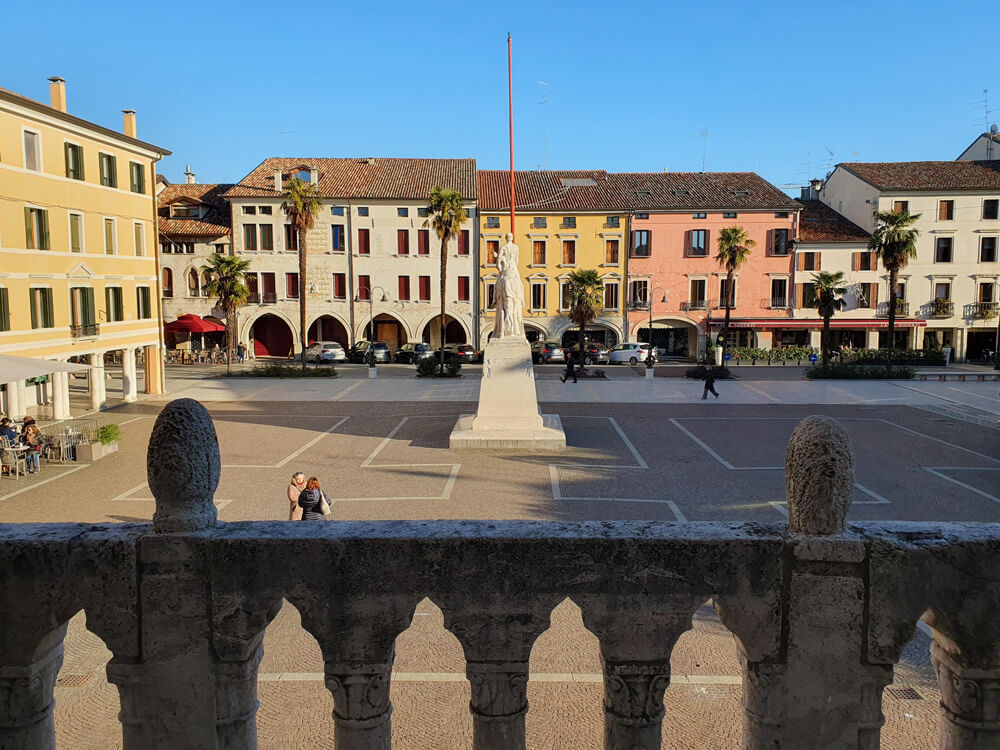
Just beyond Piazza della Repubblica is Portogruaro’s cathedral (Duomo) and its picturesquely leaning belltower. The wonky campanile is among the long list of Italy’s leaning towers; despite its slant, the twelfth-century construction was altered in the nineteenth century to add more height. The earlier cathedral alongside the tower was rebuilt in neoclassical style at the end of the eighteenth century, and has a plain appearance. Inside are some mildly interesting artworks, including a Crucifixion by Palma il Giovane.
Heading around the side of the Palazzo Comunale or the cathedral will bring you to the town’s most delightful corner: the riverside. Here a loggia with a wooden chapel beneath it looks out over the river. The Loggiata della Pescheria was where fishermen from Caorle would sell their catch alongside the historic port, and the chapel under the arches, a beloved local spot, is known as the Oratorio della Madonna della Pescheria or dei Pescatori (‘of the fishermen’).
Alongside this pretty scene and making it even more special is a proud symbol of the town – two historic water mills, the Mulini di Sant’Andrea, with waterwheels turning. You can walk right past these on a footbridge for photo opportunities or to visit the contemporary art gallery here. On the stone bridge beyond, another Venetian lion guards the waterway and road.
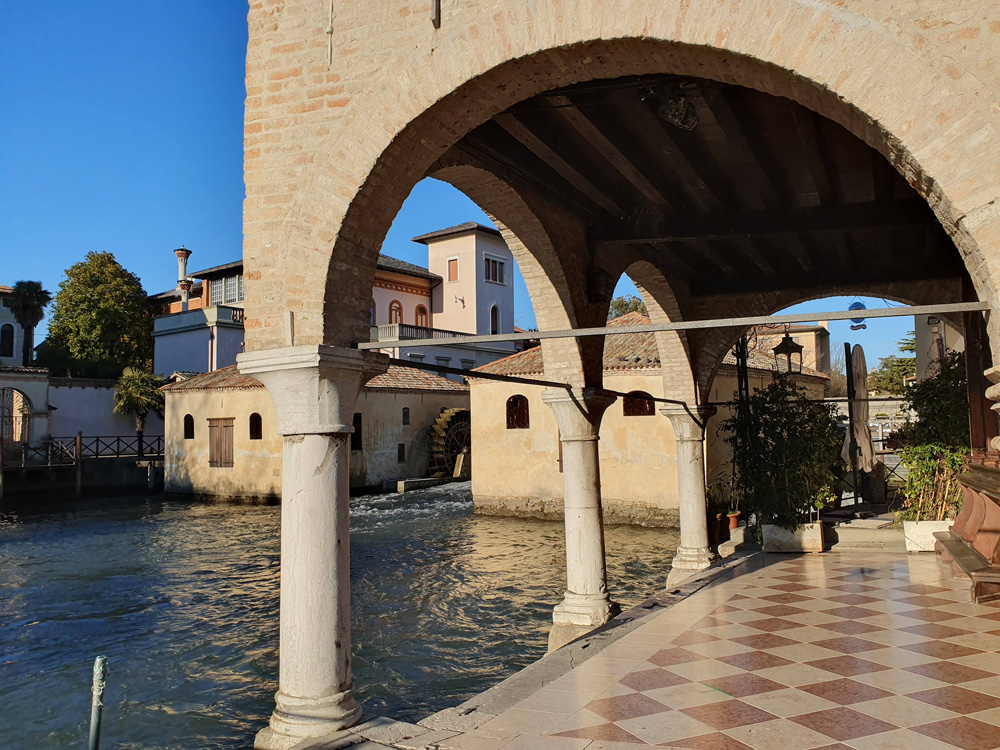
On the far side of the river, a footpath (unfortunately closed due to storm damage when I visited) follows the riverbank along towards the archaeological museum, offering a classic picture-postcard view of Portogruaro, with the arched loggia seen from across the river.
Portogruaro’s two finest streets snake on either side of the river, both long and lined with historic buildings. Their names change along their route, but the central sections are named Corso Martiri della Libertà, on which stands Piazza della Repubblica and Piazza Duomo, and the quieter Via Seminario, where you’ll find the archaeological museum. Strolling down these streets and admiring the buildings on either side is a laidback and peaceful part of the experience of enjoying Portogruaro.
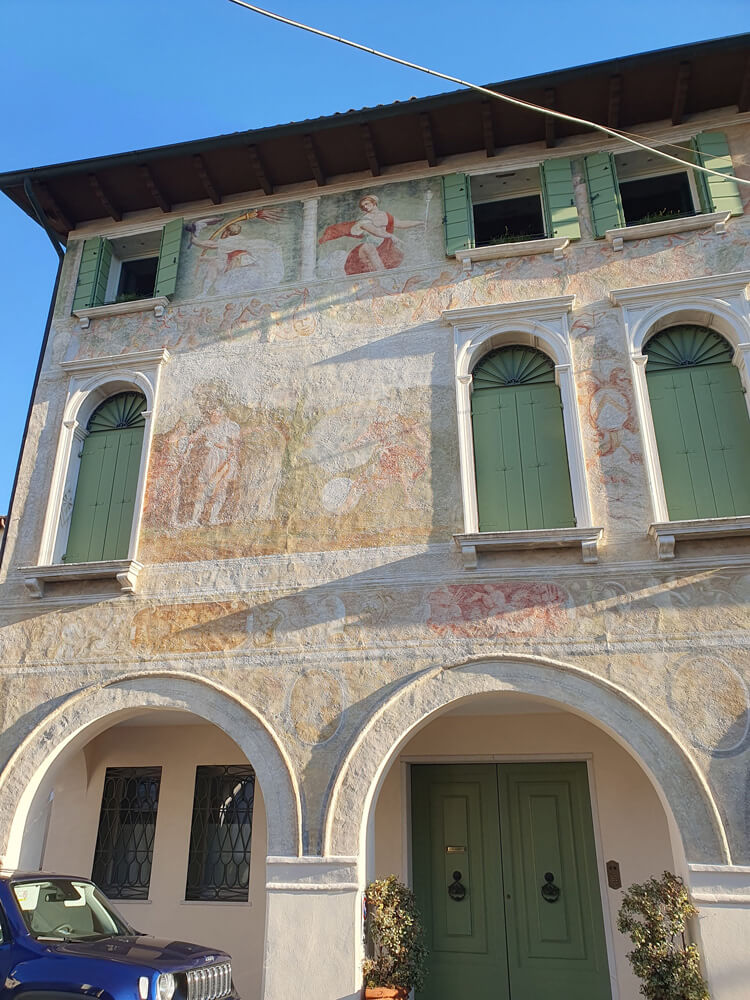
In its medieval days, Portogruaro was circled by town walls. These are gone now, though three of the old gateways, topped with towers, still remain. One of these, the Porta Sant’Agnese, now houses a small museum.
If you fancy a stroll surrounded by greenery during your visit, take a walk to the Villa Comunale and Parco della Pace off Via Seminario, once the grounds of a historic villa and now a public park.
There’s a tourist Infopoint (limited opening hours) in the Villa Comunale park, on Via Seminario, and another covering the Eastern Veneto area at Piazza Repubblica 7. Look out for information here or on the council website for any events or exhibitions locally, as well as the latest opening times. In summer, boat trips on the river are sometimes organised between Concordia Sagittaria and Portogruaro, and longer-distance, between Caorle and Portogruaro. Portogruaro’s weekly market is held on Thursday mornings in the historic centre, and other events like boat trips are often scheduled to time with this.
Museums and attractions
Portogruaro’s one significant, specific tourist attraction is the excellent archaeological museum dedicated to finds from the surrounding area, most related to the Roman colony of Iulia Concordia, present-day Concordia Sagittaria, a couple of miles away.
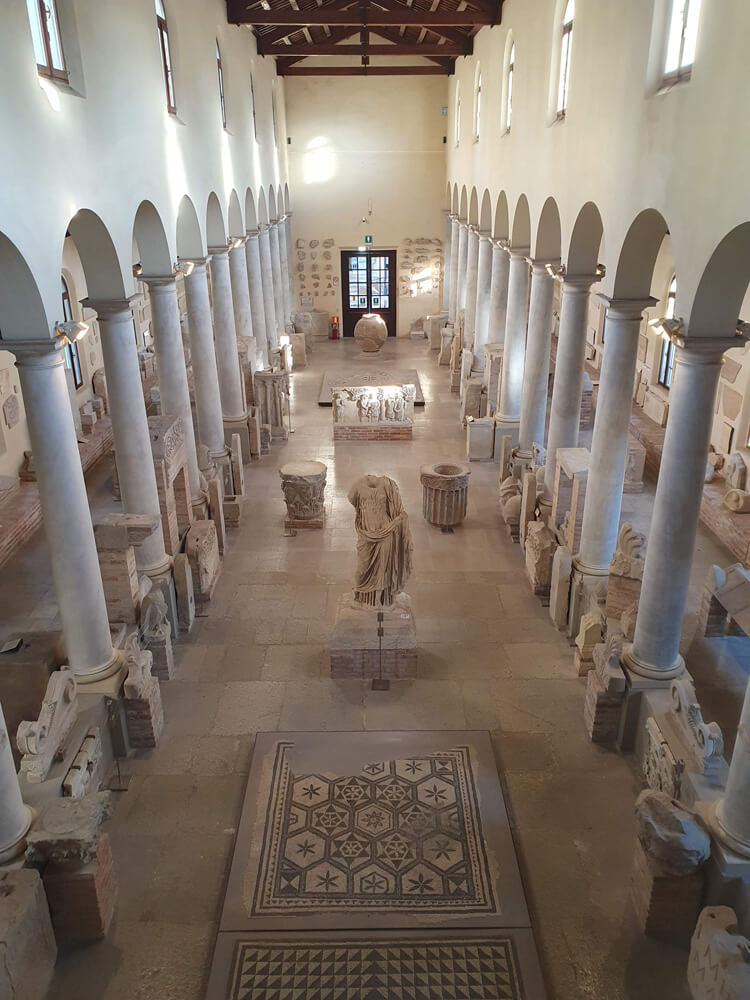
The purpose-built Museo Archeologico Nazionale Concordiese was designed in the form of an early Christian basilica, like the one in Concordia, to tie the displays in with their place of origin. A worthy and pioneering institution, it was opened in 1888, to make the history and archaeological finds from Iulia Concordia accessible to visitors – as a public transport user, I was gratified to read that proximity to the railway station determined the choice of location. Based around a bequest from a local family and material excavated locally, it’s been added to over the years, mostly with local finds. When I visited there were copies available of an excellent, illustrated bilingual guide to the museum and archaeological site available in return for a donation.
The long, wide ground-floor hall contains sculptures, mosaics, gravestones and reliefs. The large headless statue of a woman probably represents a member of the imperial family, or maybe a local noblewoman given the characteristics of a goddess; it stood in the Forum of the Roman colony. A rougher bas relief of Medusa was also found at the Forum, where it was part of the base of a column.
There are many inscriptions and funerary monuments here, mostly from the excavated cemeteries of Iulia Concordia, and these tell histories of the people who lived in the town along with its administrative and social structure. Look out for a funerary altar featuring the stock-in-trade of a butcher: a cleaver, leg of ham, scales. Others record a doctor and his wife, and another an architect. One monument is testament to the loving relationship of two slaves; although slaves were not officially allowed to marry, Epaphroditus dedicated the inscription to his ‘wife’ Saturnina. A damaged mosaic of the Three Graces is the one polychrome mosaic found in Iulia Concordia, presumably belonging to one of the town’s wealthiest homes.
Upstairs in the museum, a couple of rooms house smaller finds including small bronze items, ceramics, glass and terracotta lamps – a particularly interesting lamp is decorated with gladiatorial weapons. One of the most thought-provoking highlights is a bronze statuette of Diana the huntress, bearing an inscription dated a century or two after its creation, in which a soldier dedicates it to a god.
The museum has a combined entrance ticket with the archaeological site next to the cathedral in Concordia Sagittaria. Check latest opening times: Museo Nazionale Concordiese di Portogruaro e Area Archeologica di Concordia Sagittaria

Another small museum, dedicated to the town’s history, is housed in the Torre di Sant’Agnese, one of the old gateways in the now-gone town walls. This has limited opening hours: Museo della Città.
A short way outside the Porta Sant’Agnese is the fourteenth-century church of Sant’Agnese and Santa Lucia, once atttached to a convent. Inside are fifteenth-century frescoes and a Renaissance terracotta Pietà. I particularly liked the rose window over the main door, dating to the 1920s, showing (I believe) the scene of St Agnes and virgins accepting the prayers of the Emperor Constantine and his daughter St Constance; Agnes miraculously healed Constance of leprosy and Constantine built a church in Rome to honour her.
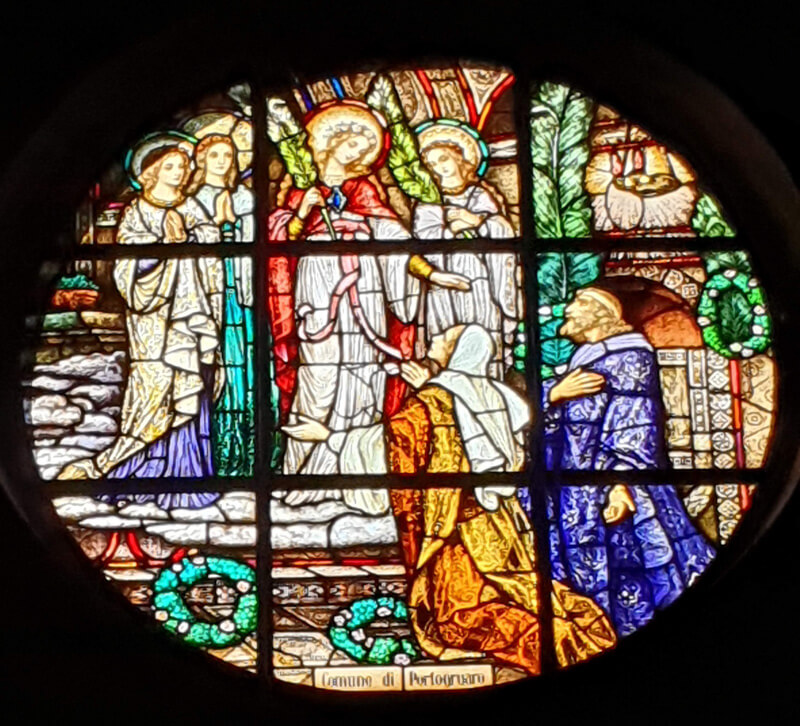
I visited the town to see a temporary exhibition housed in the old bishops’ palace, the Palazzo Vescovile, close to the archaeological museum. If you’re in the area, it’s worth checking for any local events or exhibitions during your stay. The local council website is a helpful resource for checking what’s on and opening times, including that of their tourist information office: Comune di Portogruaro.
A final, unusual sight – one that you can’t miss if you’re arriving by train – is an industrial monument that stands like a ruined cathedral opposite the railway station. The Fabbrica Perfosfati was a fertiliser factory built in 1949, designed by engineer Guido Ceruti, with tall arches made of reinforced concrete. After years of abandonment, the structure of the building has been stripped back and made secure and the Ex-Perfosfati stands, pending future developments, as a local landmark and monument to the people who worked here.
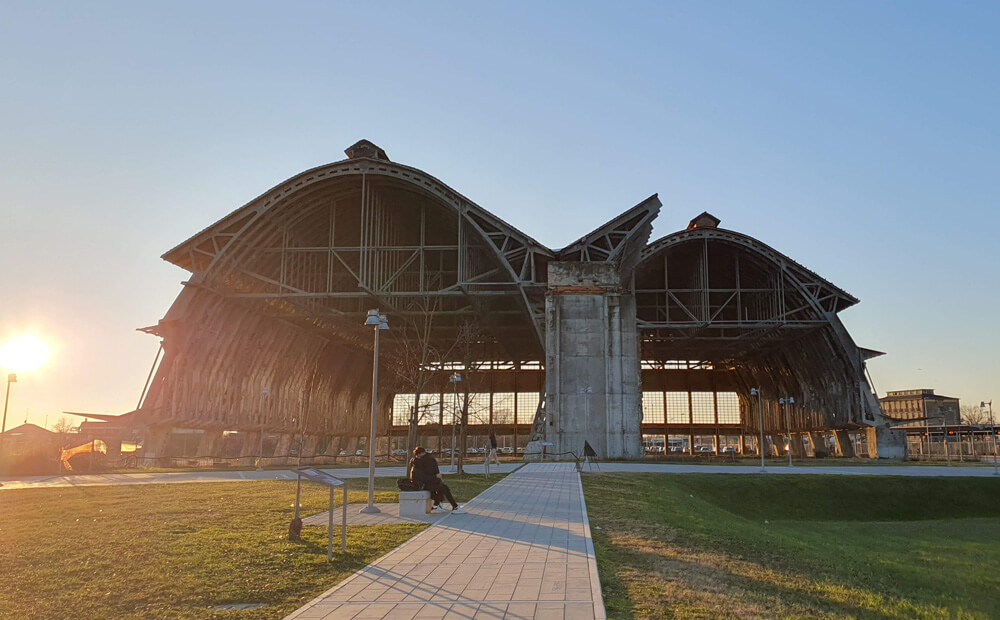
Eating, drinking and shopping
Under the arches of the two main streets of the historic centre you’ll find shops and cafés; outdoor tables on Corso Martiri della Liberta and around Piazza della Repubblica make good places to sit and enjoy the atmosphere.
There are several nice places to eat in Portogruaro. I enjoyed lunch at the Osteria Trattoria Ai Ciclisti in the heart of town on Via Mazzini, a popular and welcoming restaurant with a menu specialising in meat/fish – grilled meats in particular – but also with couple of local and seasonal vegetarian dishes on the day’s menu. I enjoyed caramelle (sweet-shaped) pasta with radicchio and mountain cheese, followed by cheesy frico and polenta, a speciality of the Friuli region nearby.
Why visit Portogruaro?
Part of the charm of visiting Portogruaro is simply losing yourself in a characteristic and delightful small Veneto town off the tourist trail. If, like me, you’re already familiar with the art cities of the surrounding area, this makes a refreshing exploration. The area’s Roman past and the archaeological museum are an attraction for history-lovers. Maybe an exhibition in town will take your fancy, or you fancy stopping off during a journey for a couple of hours strolling and dining in these pretty surroundings.
The photogenic scenery of the riverside and Piazza della Republicca are an attraction for anyone who loves the patina of centuries and the appeal of Italian architecture. If you are staying nearby, for example by the sea, Portogruaro makes a nice day or half-day trip destination for a change of scenery and atmosphere.
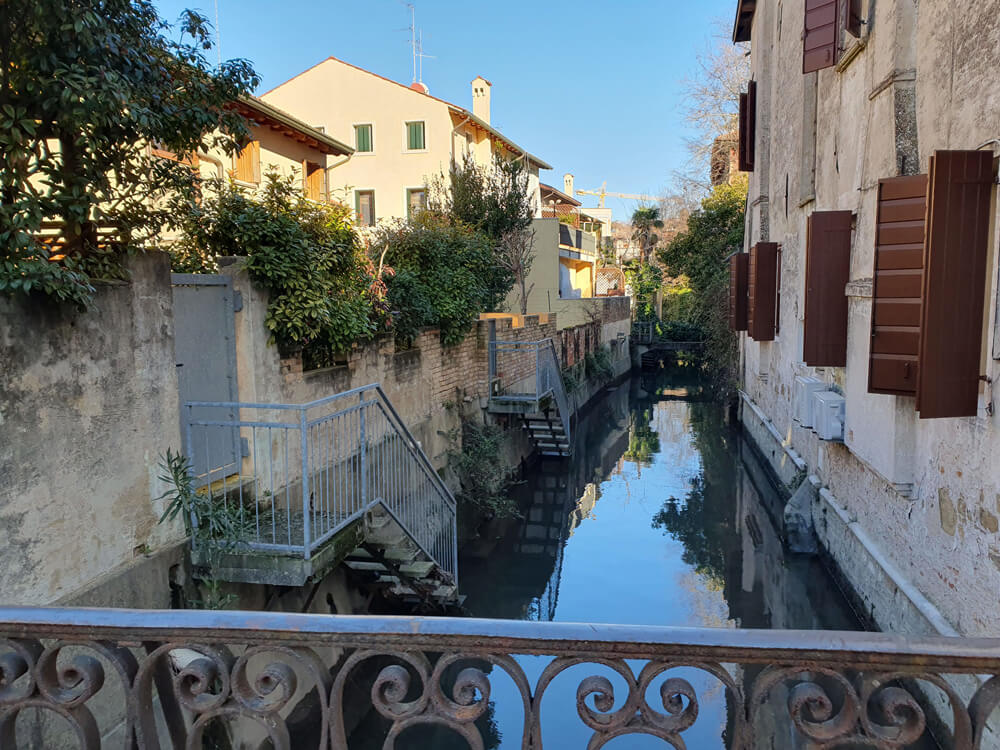
Get to Portogruaro
Portogruaro railway station (called Portogruaro-Caorle) is around a 10-minute walk from the historic centre. It’s on a railway line connecting Venice and Trieste – but note that not all the trains connecting those two cities take this route. Check timetables in advance to find which trains stop at Portogruaro, along with journey times and prices, which vary according to the category of train you take. At the station there are toilets and a bar. Bus services also connect Venice with Portogruaro, as described in the next paragraph.
If you are flying to the area, the most convenient airport is Venezia Marco Polo, Venice’s main airport. From here you have a couple of public transport options for reaching Portogruaro. A bus service run by ATVO stops at both the airport and Portogruaro, taking around 40 minutes (service 8A, its full route starting from Venice Piazzale Roma and ending at Latisana/Bibione). Alternatively, you could take a bus (ACTV or ATVO) from the airport to Venezia Mestre station, and then catch a train to Portogruaro. The second option is likely to take longer as a journey, but may work out quicker overall, depending on your flight arrival time, as there are likely to be more frequent services.
Just outside Portogruaro-Caorle railway station is a bus station with an ATVO ticket office and rows of well-labelled bus stops; easily visible to your right as you leave the train station. I picked up a bus timetable and local map at the ticket office, as well as buying bus tickets. Buses from here run to Concordia Sagittaria, a good destination to pair with Portogruaro, Caorle and other destinations in the surrounding area. At the time of writing, it’s possible to buy ‘Caorle link’ train tickets which include the bus journey to Caorle (enter ‘Caorle’ as your destination on the Trenitalia website).
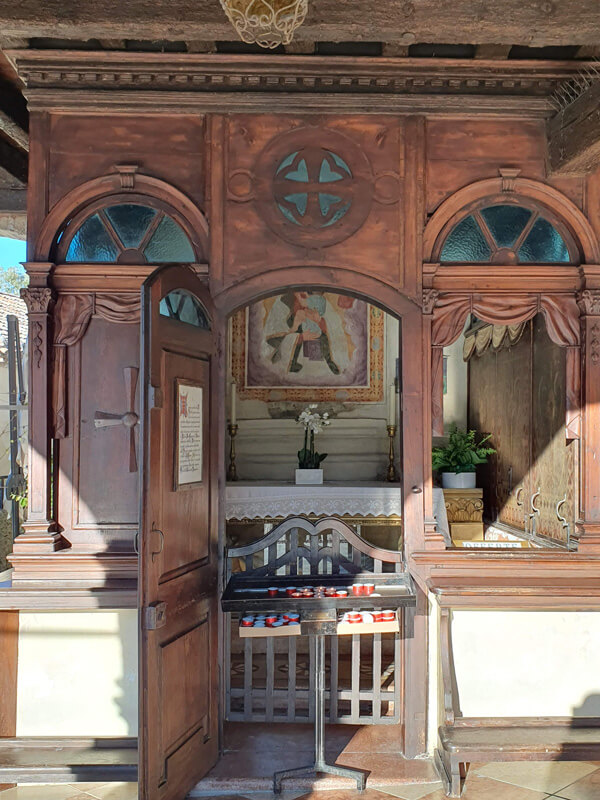
Visiting Portogruaro – its surroundings and touring itineraries
If you’re interested in history, I’d strongly recommend that when visiting Portogruaro you also pay a visit to neighbouring Concordia Sagittaria. While I loved exploring Portogruaro, the unanticipated highlight of my day was discovering the delightful 11th-century baptistery in Concordia. A few minutes by bus or car, or a riverside walk away, Concordia is easy to fit into the same day as Portoguraro – just check opening hours and bus timetables beforehand to optimise your use of time.
The same bus that connects Portogruaro railway station with Concordia Sagittaria (skirting the historic heart of Portogruaro) continues on to Caorle, a 45-minute journey away. An attractive and historic beach resort with interesting scenery, Caorle is a popular summer holiday destination. If you are prepared for a long and busy day, you could conceivably visit all three towns, though I think Caorle and Portogruaro would be best seen over two days – or longer if you’re keen on beach time, cycling or relaxing.
Portogruaro makes a good excursion from Caorle, if you’re on holiday there. It’s also worth considering as a stop (maybe overnight) if you’re travelling between Venice and the region of Friuli-Venezia Giulia, with its tourist destinations such as Trieste and Udine. Aquileia, Grado and Cividale del Friuli make great destinations on an itinerary for those interested in Roman and ‘Dark Age’ history, churches and art.
I visited Portogruaro on a day trip from Venice (which you could make in reverse if you’re staying in Portogruaro). The faster regional trains take 55 minutes for the journey from Venezia Santa Lucia station (onward destinations and journey duration vary, so check the timetable closely). While there are more obvious and sight-filled places to visit nearer to Venice, if you’ve already seen these or simply fancy something different, this is an enjoyable and low-key excursion.
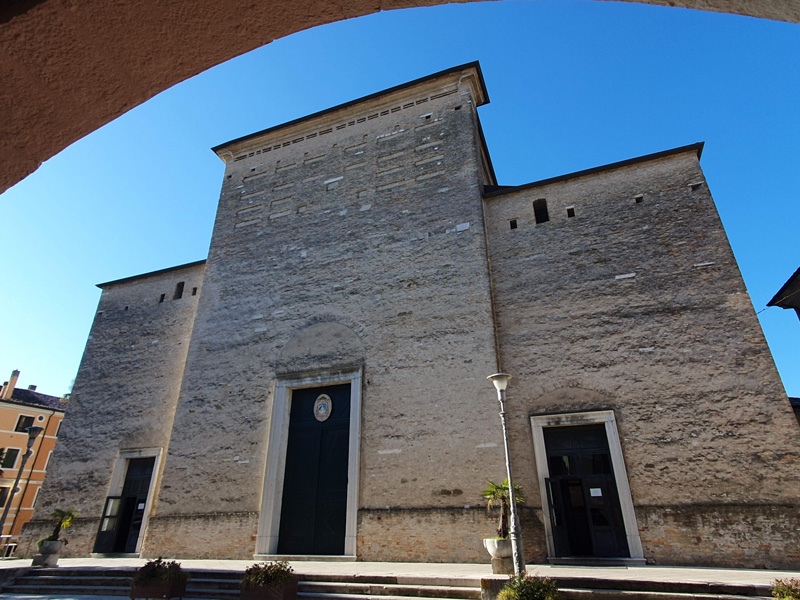
I caught the train from Venice to Portogruaro (note; the first stage of my train journey, from Venice Santa Lucia station to Mestre, was cancelled, so passengers had to take the next regional train to Venezia Mestre then hurry for our original Trieste via Portogruaro train, which was held at its platform for us – I only found this out by asking about the cancelled train at the ticket office). Outside Portogruaro station I headed to the adjacent ATVO ticket office to buy a return bus ticket to Concordia. While waiting for the Caorle bus, I strolled over to the admire the industrial cathedral-like Ex-Perfosfati ruin opposite.
Once on the bus I asked the driver to drop me for the Cattedrale in Concordia; though as it turned out the stop was fairly obvious; right opposite the cathedral. After that 10-minute bus ride, I looked around the three main sights in Concordia, all clustered together, before catching a bus back to Portogruaro. I’d checked timetables in advance to make sure the timings worked effectively. I alighted on the opposite side of Portogruaro to the railway station, where the bus stops close to the city centre (having studied the route on the outward journey). I got off a stop early to visit the church of Sant’Agnese. After spending a few hours in Portogruaro I walked to the railway station for a train back to Venice. It was a comfortable day trip, even on a shortish winter day.
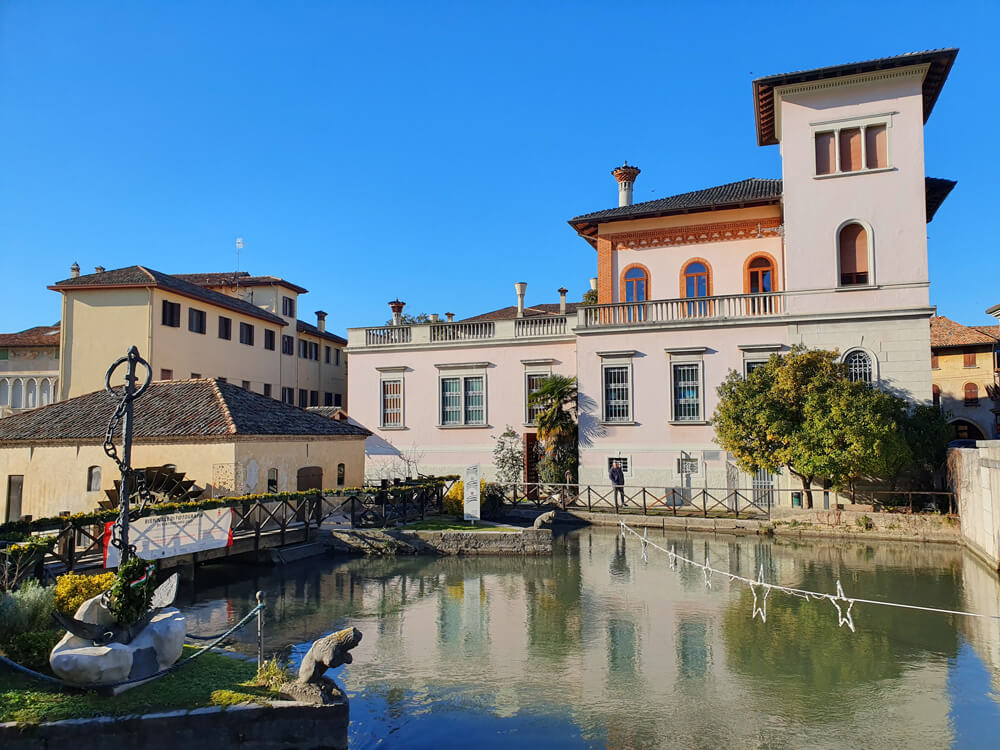
Staying in Portogruaro
There are several good accommodation options in Portogruaro, of varying types and price ranges, from town-centre hotels to comfortable apartments. More can be found in the surrounding area, suitable for those travelling by car. On the coast, Caorle has a larger number of places to stay due to its popularity as a beach resort – and some might prefer to stay there to combine history and seaside. (The links below are affiliate links – thank you for your support)
- The 4-star Hotel Spessotto is as central as you could be, right in the historic heart of town just over the road from the picturesque waterwheels
- B&B Valentino is just inside one of the old town gates; ideal for exploring the historic centre. With lots of good reviews, it’s a popular place to stay. Note that the B&B is on the far side of the centre from the railway station, so it may be worth considering the bus or a taxi if you have luggage.
- Albergo La Meridiana and the Villa delle Rose apartment are both close to the railway station, so make practical options for travellers.
- Find a hotel, B&B, apartment or villa in or around Portogruaro
Veneto destinations
- Veneto region
- Abano Terme
- Asolo
- Bassano del Grappa
- Brenta Canal
- Caorle
- Castelfranco Veneto
- Chioggia
- Cittadella
- Concordia Sagittaria
- Conegliano
- Cortina d’Ampezzo
- Lido di Jesolo
- Malcesine
- Marostica
- Monselice
- Montegrotto Terme
- Padua
- Portogruaro
- Rovigo
- Sottomarina
- Treviso
- Venetian Lagoon
- Venice
- Verona
- Vicenza
- Veneto art & architecture itinerary
- Veneto villas – Vicenza: La Rotonda & Villa Valmarana ai Nani
- Veneto villas – Villa Pisani & Villa Foscarini Rossi, Strà
- Venice Airport
- Treviso Airport
